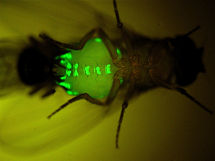
From The Scientist
Jean-Christophe Billeter from the University of Toronto at Mississauga and his colleagues genetically engineered adult Drosophila melanogaster without oenocytes, cells that secret hydrocarbons [pheromones]. …
Because pheromones have been generally believed to stimulate mating, Billeter and his colleagues expected that flies lacking hydrocarbons would be sexually unappealing to males. To their surprise, quite the opposite happened: wild-type males were hyperattracted to oenocyte-less flies. The wild-type males also ignored gender, choosing to mate with both unscented males and females over other wild-types. These results led the researchers to conclude that pheromones may not stimulate mating, but may instead act to slow down male mating attempts to allow the female to assess her partner's suitability. They also concluded that hydrocarbons help flies distinguish between sexes.
Billeter and his colleagues then tested the effect of individual pheromones on mate selection and copulation attempts. Researchers treated unscented D. melanogaster with wild-type levels of cVA, a hydrocarbon males are known to coat on females to deter further mating attempts. As expected, cVA effectively created a "chemical chastity belt," said Gompel.
Researchers then treated unscented flies with 7,11-heptacosadiene (7,11-HD), a pheromone thought to act as an aphrodisiac for flies. Although 7,11-HD alone did not stimulate additional mating attempts, when applied over cVA, it helped diminish the inhibiting effect of the compound, allowing females to broadcast their mating availability. The findings suggested that mating doesn't depend on just one pheromone relaying a message of availability, but instead on a complex mixture of attractive and aversive signals.
7,11-HD also seemed to act as a species barrier in mating. Unscented D. melanogaster females treated with the hydrocarbon attracted males of the same species, but deterred D. simulans and D. yakuba males.
"It's neat that one hydrocarbon (7, 11-HD) acts both as an aphrodisiac to males of D. melanogaster and also as a key compound causing males of other closely related species in the genus to reject her," said Tristram Wyatt, an evolutionary biologist at the University of Oxford. "It's surprising at first sight, but perhaps it's another example of evolution resulting in simple solutions, two effects for one."

No comments:
Post a Comment